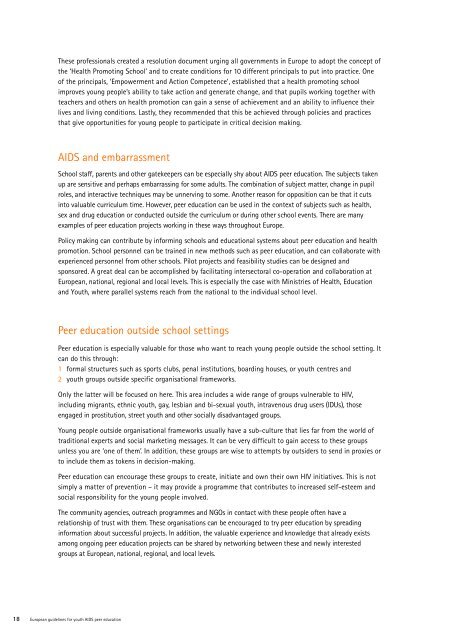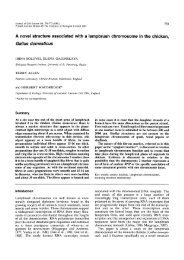European guidelines for youth AIDS peer education - University of ...
European guidelines for youth AIDS peer education - University of ...
European guidelines for youth AIDS peer education - University of ...
- No tags were found...
Create successful ePaper yourself
Turn your PDF publications into a flip-book with our unique Google optimized e-Paper software.
These pr<strong>of</strong>essionals created a resolution document urging all governments in Europe to adopt the concept <strong>of</strong>the ‘Health Promoting School’ and to create conditions <strong>for</strong> 10 different principals to put into practice. One<strong>of</strong> the principals, ‘Empowerment and Action Competence’, established that a health promoting schoolimproves young people’s ability to take action and generate change, and that pupils working together withteachers and others on health promotion can gain a sense <strong>of</strong> achievement and an ability to influence theirlives and living conditions. Lastly, they recommended that this be achieved through policies and practicesthat give opportunities <strong>for</strong> young people to participate in critical decision making.<strong>AIDS</strong> and embarrassmentSchool staff, parents and other gatekeepers can be especially shy about <strong>AIDS</strong> <strong>peer</strong> <strong>education</strong>. The subjects takenup are sensitive and perhaps embarrassing <strong>for</strong> some adults. The combination <strong>of</strong> subject matter, change in pupilroles, and interactive techniques may be unnerving to some. Another reason <strong>for</strong> opposition can be that it cutsinto valuable curriculum time. However, <strong>peer</strong> <strong>education</strong> can be used in the context <strong>of</strong> subjects such as health,sex and drug <strong>education</strong> or conducted outside the curriculum or during other school events. There are manyexamples <strong>of</strong> <strong>peer</strong> <strong>education</strong> projects working in these ways throughout Europe.Policy making can contribute by in<strong>for</strong>ming schools and <strong>education</strong>al systems about <strong>peer</strong> <strong>education</strong> and healthpromotion. School personnel can be trained in new methods such as <strong>peer</strong> <strong>education</strong>, and can collaborate withexperienced personnel from other schools. Pilot projects and feasibility studies can be designed andsponsored. A great deal can be accomplished by facilitating intersectoral co-operation and collaboration at<strong>European</strong>, national, regional and local levels. This is especially the case with Ministries <strong>of</strong> Health, Educationand Youth, where parallel systems reach from the national to the individual school level.Peer <strong>education</strong> outside school settingsPeer <strong>education</strong> is especially valuable <strong>for</strong> those who want to reach young people outside the school setting. Itcan do this through:1 <strong>for</strong>mal structures such as sports clubs, penal institutions, boarding houses, or <strong>youth</strong> centres and2 <strong>youth</strong> groups outside specific organisational frameworks.Only the latter will be focused on here. This area includes a wide range <strong>of</strong> groups vulnerable to HIV,including migrants, ethnic <strong>youth</strong>, gay, lesbian and bi-sexual <strong>youth</strong>, intravenous drug users (IDUs), thoseengaged in prostitution, street <strong>youth</strong> and other socially disadvantaged groups.Young people outside organisational frameworks usually have a sub-culture that lies far from the world <strong>of</strong>traditional experts and social marketing messages. It can be very difficult to gain access to these groupsunless you are ‘one <strong>of</strong> them’. In addition, these groups are wise to attempts by outsiders to send in proxies orto include them as tokens in decision-making.Peer <strong>education</strong> can encourage these groups to create, initiate and own their own HIV initiatives. This is notsimply a matter <strong>of</strong> prevention – it may provide a programme that contributes to increased self-esteem andsocial responsibility <strong>for</strong> the young people involved.The community agencies, outreach programmes and NGOs in contact with these people <strong>of</strong>ten have arelationship <strong>of</strong> trust with them. These organisations can be encouraged to try <strong>peer</strong> <strong>education</strong> by spreadingin<strong>for</strong>mation about successful projects. In addition, the valuable experience and knowledge that already existsamong ongoing <strong>peer</strong> <strong>education</strong> projects can be shared by networking between these and newly interestedgroups at <strong>European</strong>, national, regional, and local levels.18 <strong>European</strong> <strong>guidelines</strong> <strong>for</strong> <strong>youth</strong> <strong>AIDS</strong> <strong>peer</strong> <strong>education</strong>
















